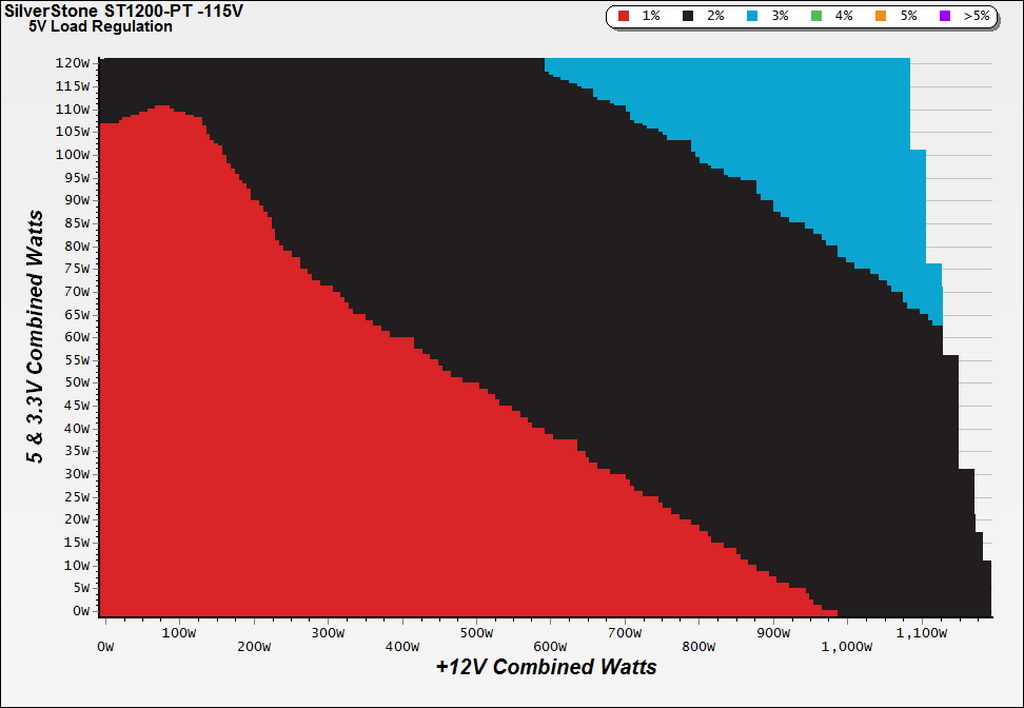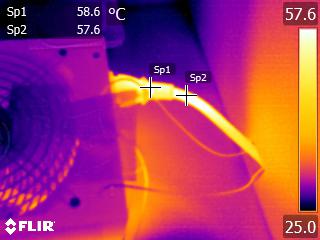SilverStone Strider Platinum ST1200-PT PSU Review
The highest-end member of SilverStone's Strider Platinum line is the ST1200-PT, and we're ready to give it an exhaustive evaluation. It achieves a high power density score thanks to compact dimensions, and there's that 1200W capacity. But is this enough?
Why you can trust Tom's Hardware
Cross-Load Tests And Infrared Images
Our cross-load tests are described in detail here.
To generate the following charts, we set our loaders to auto mode through our custom-made software before trying more than 25,000 possible load combinations with the +12V, 5V and 3.3V rails. The load regulation deviations in each of the charts below were calculated by taking the nominal values of the rails (12V, 5V and 3.3V) as point zero. The ambient temperature was between at 28°C (82.4°F) to 30°C (86°F).
Load Regulation Charts



Efficiency Chart
The sweet efficiency spot is between 320W and 630W, with the minor rails staying below a combined 55W load. If you want notably higher efficiency in this capacity category, consider investing in a pricier Titanium-class unit.
Ripple Charts - Normal Temperature




As you can see, between 28-30°C ambient the PSU's ripple suppression is fine. The problems start with increased ambient temperatures though, so we decided to run an extra set of these tests to show how the PSU behaves in a 10°C-warmer environment.
Ripple Charts - Increased Temperature
During these tests, the ambient inside our hotbox was between at 35°C (82.4°F) to 40°C (86°F).




As you can see, the +12V and 3.3V rails are most affected by the temperature change (the latter rail isn't able to keep its ripple suppression in-spec under higher load levels). A high-end PSU normally wouldn't be affected by increased ambient temperatures, and in this case we're even under the 40°C max operating limit for continuous full-power delivery.
Infrared Images
Toward the end of the cross-load tests, we took some photos of the PSU with our modified FLIR E4 camera that delivers 320x240 IR resolution (76,800 pixels).
Get Tom's Hardware's best news and in-depth reviews, straight to your inbox.






Thanks to a strong fan and aggressive fan profile, temperatures inside the PSU remain low, even under stressful conditions. The consequence is a lot of noise, though.
Current page: Cross-Load Tests And Infrared Images
Prev Page Protection Features, Evaluated Next Page Transient Response Tests
Aris Mpitziopoulos is a contributing editor at Tom's Hardware, covering PSUs.
-
powernod Wow!! Extremely impressed with Aris's more thorough "Advanced Transient Tests" !!Reply
Great to see a reviewer who never stops evolving his work!!
Amazing work Aris !!! -
Metteec Nice review, Aris. $233 is a lot to spend on a PSU. You can get a Corsair HX1200i for $210 after mail in rebate, which is a well-regarded PSU with a 7-year warranty.Reply -
jeffunit "...and as you can see, the glossy silver surface makes taking pictures difficult."Reply
It sure does, because the pictures have the exterior looking like matte black.
